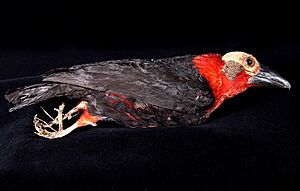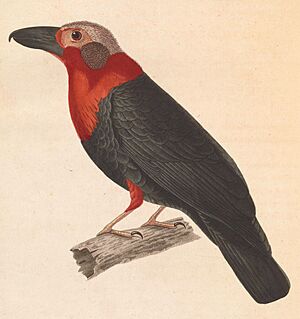Bornean bristlehead facts for kids
Quick facts for kids Bornean bristlehead |
|
|---|---|
 |
|
 |
|
| Museum specimen above (Naturalis), living individual below (Sepilok) | |
| Conservation status | |
| Scientific classification | |
| Genus: |
Pityriasis
|
| Species: |
gymnocephala
|
The Bornean bristlehead (Pityriasis gymnocephala) is a very special bird. It's the only member of its bird family, called Pityriasidae. People also call it the bristled shrike or bald-headed crow. This unique bird lives only on the island of Borneo in Southeast Asia. It usually hangs out in small groups high up in the rainforest trees. Sadly, it is a vulnerable species, meaning its numbers are decreasing.
Contents
What is the Bornean Bristlehead?
The Bornean bristlehead is a medium-sized bird, about 25 centimeters (10 inches) long. It's mostly black, but it has bright red on its legs, head, throat, and neck. Its cheeks are grey.
Why is it called "Bristlehead"?
The top of its head is bright yellow and has no feathers! Instead, it's covered in short, stiff, bristle-like bumps, about 3-4 millimeters long. This makes it look bald from far away. This unique feature gives the bird its common name, "bristlehead." The scientific name Pityriasis comes from a Greek word meaning "having dandruff," and gymnocephala means "bald-headed."
How does it look and sound?
Some females and a few males have red patches on their sides, but these can be hidden by their wings. When it flies, you might see a white patch on its wings. It has a big, strong, hooked black beak and a short tail, which makes it look quite chunky.
Young bristleheads have mostly black legs and a more orange-red head and neck. Their ear-coverts (the feathers covering their ears) are also orange-red. They might have some red spots on their belly and a few red feathers on their head, but their bristles aren't fully grown yet.
This bird is quite noisy! It makes many different sounds, like high-pitched whining, harsh notes, chattering, whistles, and honks.
Where do Bornean Bristleheads live?
The Bornean bristlehead lives only on the island of Borneo. You can find them across the island, but they are usually spread out and not in huge numbers. Sometimes, they can be common in certain areas.
What is their habitat like?
They mostly live in lowland forests, but they can also be found in hilly areas up to 1,200 meters (about 3,900 feet) above sea level. They prefer the tops of trees in both old, untouched forests and forests that have grown back after being cut down. This includes peat swamp forests, mixed dipterocarp forests (a type of rainforest), and even mangrove forests near the coast.
How do Bornean Bristleheads behave?
Bornean bristleheads are very social birds. They often move together in small, chatty groups of up to 10 birds. They usually stay in the middle and upper parts of the forest canopy (the highest layer of trees). Sometimes, they join other large or medium-sized forest birds, like malkohas, babblers, drongos, and hornbills, to form "mixed-species feeding flocks." This means different types of birds hunt for food together.
When they move through the trees, they are slow and heavy. When they fly, they flap their wings quickly but not very deeply.
What do Bornean Bristleheads eat?
Bornean bristleheads mostly eat animals. Their main food is large insects and other arthropods (like spiders). They also eat small vertebrates, such as lizards and frogs. They find their food by picking it off leaves, twigs, branches, and tree trunks, usually in the middle and upper parts of the forest. Sometimes, they will also eat fruits.
Do they breed together?
Not much is known about how these birds raise their young. Scientists once found an egg that was white with grey and brown spots, measuring about 31 by 25 millimeters. There was also a sighting of two adult females feeding a young bird, which suggests that they might help each other raise their chicks. Birds have also been seen carrying materials for nests while flying.
Why are Bornean Bristleheads vulnerable?
The Bornean bristlehead is considered a vulnerable species. This is mainly because of the fast and ongoing deforestation (cutting down forests) in Borneo. The burning of peat swamp forests also destroys their homes.
What are the threats?
The main place where these birds live is Borneo's lowland forests. Sadly, about 2.5% of these forests are lost every year. Even some protected areas where the bristleheads live are affected by illegal logging, where trees are cut down without permission. Protecting these forests is very important to help the Bornean bristlehead survive.



